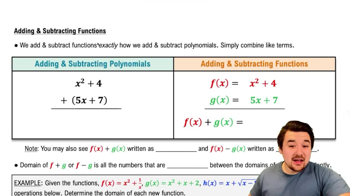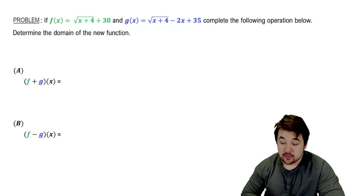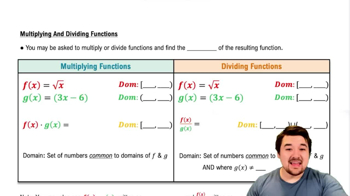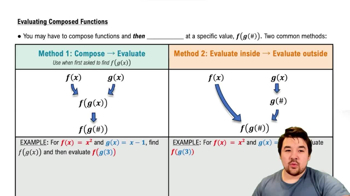Table of contents
- 0. Functions7h 52m
- Introduction to Functions16m
- Piecewise Functions10m
- Properties of Functions9m
- Common Functions1h 8m
- Transformations5m
- Combining Functions27m
- Exponent rules32m
- Exponential Functions28m
- Logarithmic Functions24m
- Properties of Logarithms34m
- Exponential & Logarithmic Equations35m
- Introduction to Trigonometric Functions38m
- Graphs of Trigonometric Functions44m
- Trigonometric Identities47m
- Inverse Trigonometric Functions48m
- 1. Limits and Continuity2h 2m
- 2. Intro to Derivatives1h 33m
- 3. Techniques of Differentiation3h 18m
- 4. Applications of Derivatives2h 38m
- 5. Graphical Applications of Derivatives6h 2m
- 6. Derivatives of Inverse, Exponential, & Logarithmic Functions2h 37m
- 7. Antiderivatives & Indefinite Integrals1h 26m
0. Functions
Combining Functions
Problem 15d
Textbook Question
Use the graphs of ƒ and g in the figure to determine the following function values. y = f(x) ; y=g(x) <IMAGE>
d. g(ƒ(5))
 Verified step by step guidance
Verified step by step guidance1
Step 1: Identify the value of f(5) using the graph of the function f. Locate the point on the graph where x = 5 and determine the corresponding y-value, which is f(5).
Step 2: Once you have found f(5), use this value as the input for the function g. This means you will now look for g(f(5)).
Step 3: Refer to the graph of the function g. Locate the point where x equals the value of f(5) that you found in Step 1.
Step 4: Determine the corresponding y-value on the graph of g for the x-value found in Step 3. This y-value is g(f(5)).
Step 5: Summarize the process: You first found f(5) from the graph of f, then used this result as the input for g to find g(f(5)) from the graph of g.
Recommended similar problem, with video answer:
 Verified Solution
Verified SolutionThis video solution was recommended by our tutors as helpful for the problem above
Video duration:
1mPlay a video:
Was this helpful?

 5:56m
5:56mWatch next
Master Adding & Subtracting Functions with a bite sized video explanation from Nick
Start learning




